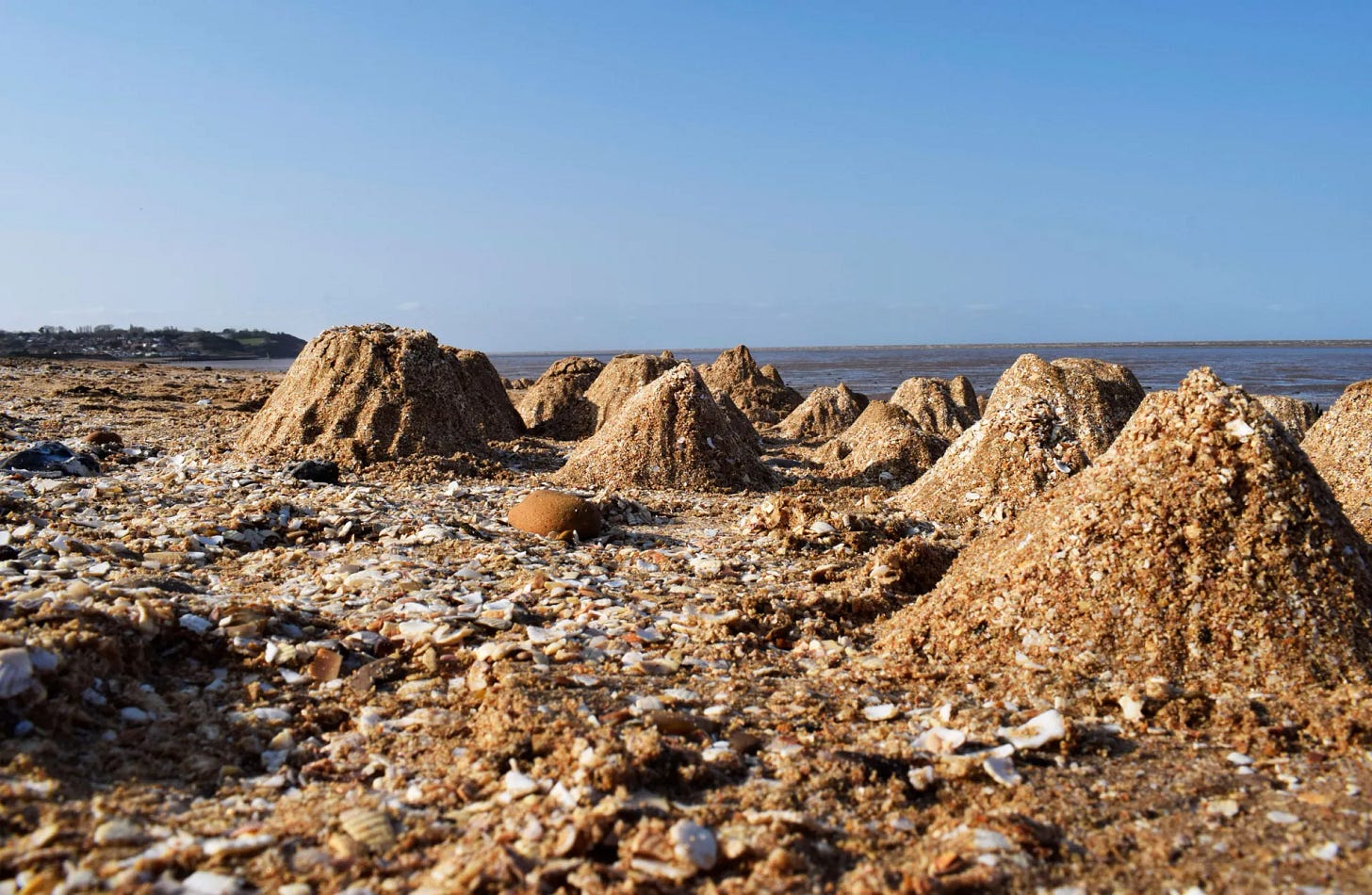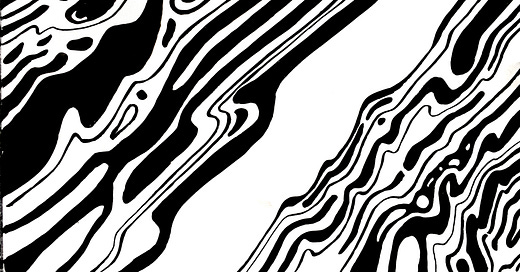Part II of SOLID.
If you missed Part I yesterday, read it here first
SOLID
to the banded iron formation [part II]
Victoria Whitworth wrote a whole book about swimming in the sea, and all the things she found out by doing it.1 Her physical and psychological connection to the sea told her things about herself, and her position in the world, and in writing about it she has peeled apart every facet of her life which has been touched by her realisations. She notes that in experiencing the features of the landscape, in that particular bit of sea and the island it touches, brings about an awareness of history and the expanse of time on Earth; ‘...the wind pimpling my skin, the spray on my right cheek, these are palpable presences in the here and now… They also reach far back in human and pre-human time.’2 Because Time is not linear. Time, in the context of the wind, for example, is neither here nor there. The wind is always the wind. What it blows upon changes, but how it operates has been the same since the formation of the planet. A breath of wind across an ancient mountain, across my mother’s face on a hill in Wales, across my forearm as I lean out of my bedroom window. It is air being pushed by heat and pressure.3
In the geology of the landscape, time has a different gauge. Relative to our understanding of hours, days and years, it is slow. You yourself were formed over millions of years, but this is impossible to grasp, as our internal clocks are set at an entirely different rate. To our eyes, the rock of the land is eternal. Whitworth allows her eyes to relax while looking out at the coastline, to filter out the details of the here and now and to imagine it overlaid with the life of times past; ‘the millenia fade away like mist from the purple hills… Time feels gossamer-thin, the profiles of hill and cliff eternal verities.’4 In the 2001 animated film, Das Rad, two rock formations have a conversation while humans rise and fall. A few sentences are exchanged between the characters Hew and Kew in the time it takes for humankind to invent the wheel, build a metropolis and then burn it down.5 I wonder what your view would be, since you hardened into a solid mass, your lifespan more than 2.5 billion years. Have you noticed you’re on the other side of the planet in a museum yet?
In their conversation for Radio 4 podcast Only Artists6, artist Katie Paterson and novelist David Mitchell spend almost half an hour gushing about each other’s work, but in the final five minutes they almost have an argument. Mitchell laments that it is easy to become a ‘slave to the metaphor’ when dealing with time, whether that metaphor is a river, a train or a line, when Paterson cuts him off and declares that ‘it just is the river, it’s not a metaphor, it just is it!’7 In a Bergsonian sense, the matter of the landscape is formed directly by the passing of time, meaning that the mountains, trees, new life and evolution of species yet to exist, rely on the passing of time to come into being.8 Paterson explains that in her work First There Is a Mountain (Fig. 2), ‘the mountain is the time’.9 I think that for a writer it may be difficult to comprehend an artist’s approach to representing such a concept as time, their rejection of metaphor and their easy assertion that the ‘thing’ just is. For this work, Paterson took 3D models of five of the world’s mountains and had ‘sand pails’ made in their form, so that participants could use these to make temporary sandcastle mountain ranges on beaches across the UK.10 There is a very literal linking of ideas in this work, the physical placing of mountains from foreign lands on UK shorelines, the miniscule relative scale of the buckets to their subjects. The grains of sand, these tiny, loose, free-flowing particles being packed together for a few minutes or hours to represent a solid formation which has existed for billions of years. For me, this literalness is perfect. Because the actual, real mountains the sandcastles are modelled on are not actually solid either. Not when you look at it with a wider view of time. Again we must consider the relativity of geological time, the false perception we have that rocks are static entities. When a participant builds that sand mountain they are re-enacting a macro process on a micro scale, depicting a gargantuan geological upheaval with ease.

Mitchell observes that Paterson seems able to ‘escape’ the confines of language and metaphor by making artworks which need no language to be made or understood.11 By accessing the materiality of time directly, she is allowing us to bear witness to our own existence in time in an extremely visceral way, in a similar but much deeper way than when I reach out to touch your russet bands. Timothy Morton’s Hyperobjects tells us that there exist in the universe a number of objects so large and complex that they cannot be understood or viewed in their entirety. These objects span vast geographical areas, and occupy both a material and a metaphysical space. The way we experience them is mostly through their effects rather than their actual physical matter, and with that, Morton argues, we can see that they also transcend any sort of temporality.12 When Timothy Morton is describing the ‘interobjectivity’ of Hyperobjects, he asks us to imagine London and all its constituent parts; ‘The streets beneath the streets, the Roman Wall, the boarded-up houses, the unexploded bombs, are records of everything that happened to London. London’s history is its form. Form is memory.’13 This literal representation of time as material is so striking, and yet when I think about it, seems so logical and obvious. Morton references Ruskin’s ‘stain of time’ in relation to the build-up of dirt on London’s buildings as being part of their history and their material form.14 Just as Kathleen Jamie’s cave soot-stain allows her to see the fire that caused it, objects everywhere, you included, allow us to access the past through their very fabric. They are a stark reminder of non-linearity; the past is now, it’s staring us in the face.
⬟⯂⬟
The landscape itself is an access-point to history. Often, probably unintentionally, we think of it as something we ‘look at’ or ‘go to’; I’m over here, and it’s over there. We are distanced and detached from it, and by extension, we are displaced from the past. Owen Sheers draws a direct comparison between the way landscape and text operate. Unlike Paterson, the poet Sheers sees the non-verbal language of the landscape as the same as the linguistic reality of poetry. The words are in the same category as the material, and are treated the same. They are both a method by which to ‘situate’ us, and to translate ‘a multitude of vaguer sensations and thoughts about the place’15 For Sheers, the ‘stuff’ of history and place needs decoding. It cannot just be.
I think our distancing from the landscape is something we have made up out of a sense of self-importance, and a need for control, but often borne out of good intentions. Imagining a national park, say, the Lake District, we can see that it fulfils the criteria of a Hyperobject: it’s physically huge, its components are spread across space-time and it would be impossible to experience or even comprehend it in its entirety. But despite their great size, we love to ‘take care’ of our National Parks, to steward and manage, because we desperately want to preserve their beauty as if it were a precious asset belonging to us. In doing so though, we end up exerting our own agenda onto it. Aldo Leopold was writing about cohesion between land and humans as an ethical necessity in the first half of the 20th century, introducing a ‘land ethic [to] change the role of Homo sapiens from conqueror of the land-community to plain member and citizen of it.’16 Somewhat before his time, he had identified a need to counteract the human effects of industry on the landscape by actively tuning into its rhythms and inserting ourselves into its systems as a participant rather than an owner. Certainly from my perspective, though, this stewardship has taken on the opposite effect, especially in our small country with such a perceived density of people17 and therefore a sense of urgency about preserving ‘green spaces’. It once seemed to me to be a positive and wholly responsible enterprise, but the more I thought about it, the more I wondered about how it might be problematic, in that it denotes care and attention on its face, but the subtext is still really about ownership.
The entwining of an ethical ecological responsibility and a drive for development for housing, farming and industry is tight, and sometimes hard to pull apart. So when I’m trying to talk about exactly how we interact and intervene with the landscape, it gets tricky. There is a complex conversation here, a wider conversation about the extremes of land intervention; the socioeconomic and health crises that have been spurred by land development, ownership and control locally, nationally and internationally, and by resource mining the world over. Nancy Tuana mentions many in her essay Viscous Porosity, but the central theme of the work is the effects of Hurricane Katrina on New Orleans.The majority of those most severely affected by flooding caused by the hurricane were situated in poorer neighbourhoods, the floodwater diverted by damaged levees and carrying pollution and disease straight into their homes. Some believed this damage was deliberately perpetrated by the authorities in order to protect richer areas, and this belief, Tuana says, is borne from the legacy of a similar event in 1927.18 Collective memory has cemented apparent truths about the landscape. Here, history and memory are materially present.
⬟⯂⬟
Part III coming tomorrow :)
Victoria Whitworth, Swimming With Seals (London: Head of Zeus, 2017).
Ibid. p. 7.
See <https://www.nationalgeographic.com/science/earth/earths-atmosphere/wind/> [accessed 3 July 2020].
Ibid. p. 123.
Das Rad, dir. by Chris Stenner, Arvid Uibel, Heidi Wittlinger (Filmakademie Baden-Württemberg: 2001)
BBC Radio 4, "Katie Paterson Meets David Mitchell", Only Artists, 2019 <https://www.bbc.co.uk/programmes/m000b0b8> [Accessed 2 July 2020].
Ibid., 24:50-25:26.
Henri Bergson, Creative Evolution, trans. by Arthur Mitchell (New York, N.Y.: Henry Holt and Company 1911), p.28-29.
BBC Radio 4, "Katie Paterson Meets David Mitchell", Only Artists, (25:30-25:35).
Katie Paterson, ‘First There is a Mountain - About’ <https://www.firstthereisamountain.com/about> [accessed 2 July 2020].
BBC Radio 4, "Katie Paterson Meets David Mitchell", Only Artists, (27:12-27:22).
Timothy Morton, Hyperobjects: Philosophy and Ecology after the End of the World (Minneapolis, Minn.: University of Minnesota Press, 2013).
Ibid. p. 76.
Ibid.
Owen Sheers, ‘Poetry and place: some personal reflections’ in Geography, 93 (3) (2008), 172-175 (p. 173).
Aldo Leopold, A Sand County Almanac, (Oxford: Oxford University Press, 1949), p.204.
The UK is actually the 46th most densely populated country in the world. See: <https://data.worldbank.org/indicator/EN.POP.DNST?most_recent_value_desc=false> [accessed 4 July 2020].
Nancy Tuana, ‘Viscous Porosity: Witnessing Katrina’, in Material Feminisms, ed. by Stacey Alaimo and Susan Hekman (Bloomington, Ind.: Indiana University Press, 2008) pp.188-213 (p.203).


